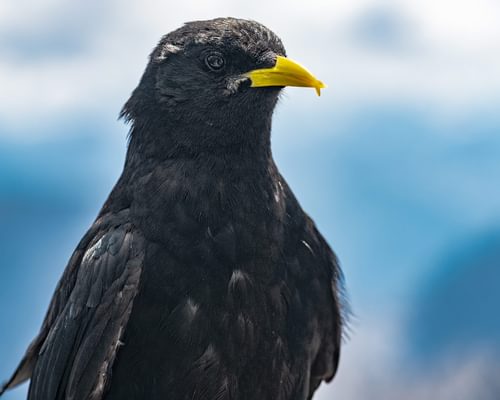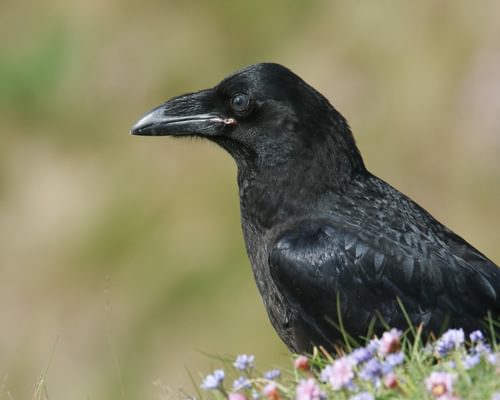Red-billed Chough
Least ConcernPyrrhocorax pyrrhocorax
Visual Identification
Appearance
The Red-billed Chough is a striking corvid with glossy black plumage that shimmers with a blue-green sheen in sunlight. Its most distinctive features are its curved, bright red bill and matching red legs, which contrast sharply with its dark feathers.
Both males and females share the same appearance, with no significant differences between the sexes. Juveniles resemble adults but have duller black plumage and orange-red bills and legs that darken to the adult's vibrant red with age.
Size
Length
39cm to 43cm
Wingspan
73cm to 90cm
Weight
280g to 360g
Colours
Males and females have similar plumage
Primary Colour
Black
Secondary Colour
Red
Beak Colour
Red
Leg Colour
Red
Habitat and Distribution
Habitats
Woodland
Garden
Wetland
Coastal
Urban
Farmland
Grassland
Desert
Tundra
Rainforest
Mountain
Savanna
Distribution
Red-billed Choughs inhabit coastal cliffs, rocky hillsides, and mountainous regions across Europe, North Africa, and parts of Asia. They prefer areas with short, grazed grass for foraging and nearby rocky outcrops or old buildings for nesting.
In the UK, they are found mainly in western and northern coastal areas, including Cornwall, Wales, the Isle of Man, and parts of Scotland. Their distribution remains relatively stable throughout the year, with most populations being resident.
Elevation Range
Sea level to 3,000 meters
Climate zones
Temperate, Alpine
Distribution Map
This map gives you a rough idea of where you might spot a Red-billed Chough. The coloured areas show countries where these birds have been seen.
A few things to keep in mind:
- Birds might not be everywhere in the coloured areas, for example, they may be present around the coast of that country
- Where birds live can change with seasons and available food
- This map is quite simple - it doesn't show exact locations
We're working on making our maps even better! Soon, we hope to show you:
- More detailed maps for bigger countries, including state and region
- How birds move around during different seasons
Distribution by Region
Behaviour and Ecology
Bird Attributes
This feature is in beta. We'd love your feedback to improve it!
Share your thoughtsBird Attributes Explained
Our bird attributes system rates various aspects of a bird's capabilities on a scale of 0-100, based on data from field observations, scientific studies, and expert knowledge.
Attribute Categories:
- Agility: Manoeuvrability, speed, and grace in flight or movement.
- Strength: Physical power, often correlating with size and hunting abilities.
- Adaptability: Ability to thrive in various environments or changing conditions.
- Aggressiveness: Territorial behaviour and assertiveness, particularly during breeding seasons.
- Endurance: Stamina, often seen in migration patterns or foraging behaviours.
Understanding the Ratings:
- 0-20: Very Low
- 21-40: Low
- 41-60: Average
- 61-80: High
- 81-100: Very High
Remember, these attributes are relative to other bird species and don't necessarily indicate superiority.
Hover over the icon next to each attribute for more information.
Tap the icon next to each attribute for more information.
Agility
Reflects the bird's manoeuvrability, speed, and grace in flight or movement.
The Red-billed Chough demonstrates remarkable agility, performing acrobatic aerial displays with rolls and tumbles. Their dexterity in foraging, probing soil and crevices with precision, further showcases their nimble nature.
Strength
Indicates the bird's physical power, often correlating with size and hunting abilities.
Whilst not exceptionally strong for their size, Red-billed Choughs possess adequate strength to manipulate their environment, such as using tools to extract insects and constructing nests with various materials.
Adaptability
Represents the bird's ability to thrive in various environments or changing conditions.
These corvids show good adaptability, thriving in diverse habitats from sea level to 3,000 metres elevation. Their ability to use tools and varied foraging techniques indicates a flexible approach to survival.
Aggressiveness
Measures the bird's territorial behaviour and assertiveness, particularly during breeding seasons.
Red-billed Choughs are not notably aggressive birds. They are social and often seen in pairs or small flocks, suggesting a generally peaceful demeanour. However, like most birds, they likely defend their nests when necessary.
Endurance
Reflects the bird's stamina, often seen in migration patterns or foraging behaviours.
With a lifespan of up to 17 years in the wild and over 20 in captivity, Red-billed Choughs demonstrate good endurance. Their ability to inhabit challenging environments like coastal cliffs and mountainous regions also indicates robust stamina.
Diet
Red-billed Choughs primarily feed on insects and their larvae, including beetles, flies, and ants. They also consume small crustaceans, spiders, and occasionally seeds.
Their curved bills are perfectly adapted for probing soil and dung for prey, often following grazing animals to find insects.
Behaviour
Red-billed Choughs are highly social birds, often seen in pairs or small flocks. They perform acrobatic aerial displays, rolling and tumbling in the air while calling loudly.
On the ground, they use their curved bills to probe soil and crevices for insects, demonstrating remarkable dexterity in their foraging techniques.
Vocalisation
Red-billed Choughs are vocal birds with a distinctive repertoire. Their most common call is a high-pitched, far-carrying 'chee-ow' or 'keeah'.
During flight or social interactions, they produce various chattering and piping sounds. Their calls are often described as more melodious than those of other corvids.
Nesting & Breeding
Red-billed Choughs form monogamous pairs that often bond for life. The breeding season typically begins in April or May. Pairs engage in mutual preening and aerial displays as part of their courtship rituals.
Nests are built in crevices of cliffs, caves, or old buildings. Both partners contribute to constructing the nest using twigs, roots, and sheep's wool. The female lays 3-5 pale blue eggs with brown speckles.
Incubation lasts about 17-21 days, and it is primarily carried out by the female while the male provides food. Chicks fledge after 31-41 days but remain dependent on their parents for several more weeks.
Lifespan
The Red-billed Chough typically lives for 5 to 7 years, with a maximum recorded lifespan of 20 years.
Like all birds, lifespan can be affected by factors including predation, habitat quality, disease, and access to food sources.
Conservation and Status
Global Conservation Status
While globally listed as Least Concern, Red-billed Choughs face localised threats from habitat loss and changes in agricultural practices.
Conservation efforts in the UK, particularly in Cornwall and Wales, focus on maintaining suitable grazing regimes to preserve their foraging habitats.
Birdwatching Tips
- Look for Red-billed Choughs along coastal cliffs and mountainous areas
- Listen for their distinctive, high-pitched 'chee-ow' call
- Observe their unique red bill and legs for positive identification
- In the UK, focus on Cornwall, Wales, and parts of Scotland where they are more common
Additional Information
Quick Facts
Other names:
Cornish Chough, Cliff Crow
Family:
CorvidaePredators
Main predators of Red-billed Choughs include Peregrine Falcons, Golden Eagles, and occasionally foxes or rats that may raid nests.
Did You Know?
- Red-billed Choughs can live for over 20 years in captivity.
- They are the national bird of Cornwall and feature on its coat of arms.
- These birds have a remarkable ability to use tools, such as twigs, to extract insects from crevices.
Was this bird profile helpful?
Your feedback helps us improve our content
Thanks for your feedback!
Your input helps us improve our content.
Community Experience
Community Ratings
No ratings yet - be the first to rate this bird!
Latest Community Reviews
No reviews yet
Sign in to be the first to review
Community Reviews
Create Your Free Account Welcome Back!
Join our community to rate birds and share your experiences. Creating an account is completely free and only takes a minute. Sign in to your account to rate birds and share your experiences with our community.
Your information is secure and will never be shared.
By creating an account, you agree to our Privacy Policy.
Similar Birds
References
- 2 3 4
website: BirdLife International. 2016. Pyrrhocorax pyrrhocorax. The IUCN Red List of Threatened Species 2016: e.T22705916A87384853.
View source - 1
journalArticle, 1938: Flower, Furter notes on the duration of life in animals. IV. Birds, Proc Zool Soc London, Ser. A:195-235



